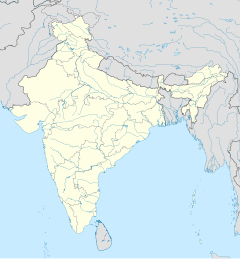Kaila Devi Temple
| Kaila Devi | |
|---|---|

A View of Temple
|
|
| Name | |
| Proper name | Kaila Devi Temple |
| Devanagari | कैलादेवी मंदिर |
| Geography | |
| Coordinates | 26°20′6.3″N 76°53′37.7″E / 26.335083°N 76.893806°ECoordinates: 26°20′6.3″N 76°53′37.7″E / 26.335083°N 76.893806°E |
| Country | India |
| State | Rajasthan |
| District | Karauli |
| Locale | Kaila Devi |
| Culture | |
| Primary deity | Durga/Lakshmi |
| Important festivals | Kaila Devi Annual Fair |
| History and governance | |
| Date built | 1600 AD |
| Creator | Shri Bhom Pal Ji |
Kaila Devi Temple is a Hindu temple situated in the Kaila Devi Village of Karauli district, in the Indian state of Rajasthan. Nearest cities is Karauli (23 km), Gangapur City (34 km), Hindaun City (58 km). The temple is located on the banks of the Kalisil River, a tributary of the Banas River in the hills of Aravali.
The temple is dedicated to the tutelary deity, Goddess Kaila Devi, of the erstwhile princely Jadon Rajput rulers of the Karauli state. It is a marble structure with a large courtyard of a checkered floor. In one place are a number of red flags planted by devotees.
These Red flags existing in the Kaila devi mandir are placed by the devotees. Devotees used to put the bhog along with these flags there in kaila devi mandir on each day of the year. The Jagran by the bhagat ji is the most attractive thing here happens every night at 09:00 PM IST in the temple. Devotees used to come there by foot from different areas of Rajastha,UP,MP and all over India in the month of Chaitra.
The annual fair of Kaila Devi is held at the village Kaila Devi in the month of Chaitra (Mar-Apr), lasting for a fortnight. Another attraction is the small temple dedicated to Bhairon, situated in the courtyard and facing the shrine of Kaila Devi is a temple of Hanuman locally called 'Languriya'.
Approximately 20,00,000 devotees mainly from Uttar Pradesh, Madhya Pradesh and Rajasthan states gather during the fair in Hindu 'Chaitra' month. The ritual of Kanak-Dandotis is observed by staunch devotees. They cover a distance of 15 to 20 km to reach the temple, not on foot but by lying prostrate, making lines with their hands in that position, advancing up to the line drawn and repeating this procedure till they reach the temple.
...
Wikipedia


